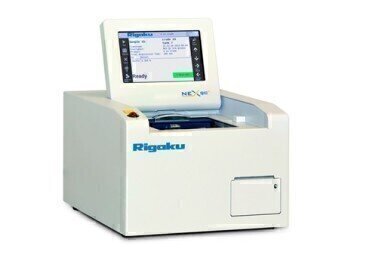-
 Rigaku NEX QC+ - high resolution benchtop Energy Dispersive X-ray Fluorescence Spectrometer.
Rigaku NEX QC+ - high resolution benchtop Energy Dispersive X-ray Fluorescence Spectrometer.
Analytical Instrumentation
Measurement of Complex Lube Oils by the Rigaku NEX QC+ EDXRF Analyser
Jun 15 2016
Quality control and quality assurance during lube oil blending and manufacturing processes is essential. Basic lube oil formulations containing only P, S, Ca and Zn are often augmented with additional elements and additives to create lubricating oils for specific needs. A fast, simple method of analysing lube oils is important throughout the QC/QA process. Rigaku meets this industry need with a high-performance low-cost benchtop energy dispersive X-ray fluorescence (EDXRF) system. Rugged and reliable, the NEX QC+ EDXRF spectrometer is an ideal tool for elemental analysis, with simple and intuitive software for the non-technical operator.
The method described here demonstrates the measurement of Mg, Si, P, S, Cl, Ca, Zn, Ba and Mo in new lube oils by the empirical approach using the Rigaku NEX QC+ high-resolution benchtop EDXRF analyser.
Instrument
The Rigaku NEX QC+ spectrometer is designed for demanding applications, or for situations where analysis time or sample throughput is critical. A silicon drift detector (SDD) affords extremely high count rate capability with excellent spectral resolution, enabling NEX QC+ to deliver the highest precision analytical results in the shortest possible measurement times.
Specifically designed for routine quality control applications, the new Rigaku NEX QC+ features an intuitive 'icon-driven' touch screen interface for easy operation and a built-in printer for convenience.
Sample preparation
Preparation is simple - Ensure each sample is homogeneous and stable and fill a 32mm XRF sample cup ¾ full (5g) and then measure the sample.
Standard and calibration
To demonstrate a complex fresh lube oil formulation for this analysis, empirical calibrations were built using a suite of 23 commercially available calibration standards. The suite of calibration standards must be representative of the lube oil formulation to be analysed. Use of empirical calibration ensures the particular lube oil formulation is exactly characterised and modeled, which yields optimum accuracy. Elements in the lube oil should span over each concentration range of interest, and the elements in the oil should vary independently of each other. Alpha corrections are then employed to automatically compensate for variations in X-ray absorption and enhancement effects within the sample due to the independent variations in element concentration.
A summary of the empirical calibrations is shown here:
|
Element |
Concentration Range |
RMS Deviation |
R2 Confidence |
|
Mg |
0.020 – 0.080 % |
0.0033 |
0.97380 |
|
Si |
0.010 – 0.045 % |
0.0005 |
0.99810 |
|
P |
0.002 – 0.250 % |
0.0026 |
0.99852 |
|
S |
0.050 – 2.500 % |
0.032 |
0.99892 |
|
Cl |
0.001 – 0.200 % |
0.0008 |
0.99988 |
|
Ca |
0.001 – 0.500 % |
0.0004 |
0.99999 |
|
Ba |
0.005 – 0.040 % |
0.0003 |
0.99964 |
|
Zn |
0.001 – 0.250 % |
0.0009 |
0.99988 |
|
Mo |
0.005 – 0.050 % |
0.0003 |
0.99972 |
Representative samples from the calibration were chosen to demonstrate typical instrument repeatability (precision). Ten repeat analyses of each sample were performed with the sample in static position using a total analysis time of 400 sec per analysis.
Conclusion
The Rigaku NEX QC+ EDXRF spectrometer offers analysts and technicians a simple yet powerful and versatile system for quantifying elemental composition of new, fresh lube oils using the empirical approach. The results of this study indicate that, given stable samples, proper sample handling and proper calibration technique, the NEX QC+ analyser can achieve excellent results measuring the elemental concentration of lubricating oils. The performance shown by this method and other Application Notes from Rigaku demonstrates that NEX QC and NEX QC+ analysers can be used to comply with ASTM D6481 for the measurement of P, S, Ca and Zn.
Please click here for EDXRF/XRF for Petroleum & Petrochem applications from Rigaku.
Digital Edition
PIN 25.1 Feb/March
March 2024
In This Edition Safety - The technology behind the ION Science Tiger XT - Safety with ammonia and LOHCs as hydrogen carriers Analytical Instrumentation - Discussion on new tribology te...
View all digital editions
Events
Apr 28 2024 Montreal, Quebec, Canada
Apr 30 2024 Birmingham, UK
May 03 2024 Seoul, South Korea
May 05 2024 Seville, Spain
May 06 2024 Riyadh, Saudi Arabia

















